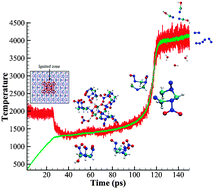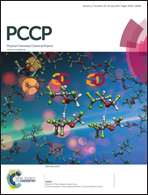Reactive simulation of the chemistry behind the condensed-phase ignition of RDX from hot spots†
Abstract
Chemical events that lead to thermal initiation and spontaneous ignition of the high-pressure phase of RDX are presented using reactive molecular dynamics simulations. In order to initiate the chemistry behind thermal ignition, approximately 5% of RDX crystal is subjected to a constant temperature thermal pulse for various time durations to create a hot spot. After application of the thermal pulse, the ensuing chemical evolution of the system is monitored using reactive molecular dynamics under adiabatic conditions. Thermal pulses lasting longer than certain time durations lead to the spontaneous ignition of RDX after an incubation period. For cases where the ignition is observed, the incubation period is dominated by intermolecular and intramolecular hydrogen transfer reactions. Contrary to the widely accepted unimolecular models of initiation chemistry, N–N bond dissociations that produce NO2 species are suppressed in the condensed phase. The gradual temperature and pressure increase in the incubation period is accompanied by the accumulation of short-lived, heavier polyradicals. The polyradicals contain intact triazine rings from the RDX molecules. At certain temperatures and pressures, the polyradicals undergo ring-opening reactions, which fuel a series of rapid exothermic chemical reactions leading to a thermal runaway regime with stable gas-products such as N2, H2O and CO2. The evolution of the RDX crystal throughout the thermal initiation, incubation and thermal runaway phases observed in the reactive simulations contains a rich diversity of condensed-phase chemistry of nitramines under high-temperature/pressure conditions.


 Please wait while we load your content...
Please wait while we load your content...